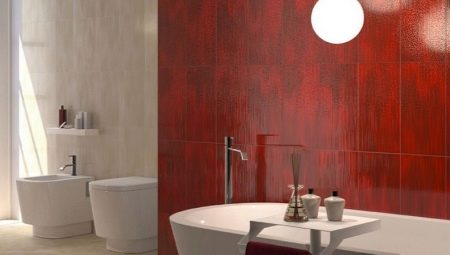The most common material for finishing areas with a high level of humidity is wall tiles. Today it is presented in a wide range. Tiles differ in the type of coating, texture, color, shape and design.
In addition to the aesthetic function, this finishing material is easy to care for, serves for a long time and allows you to create an original design in the bathroom.
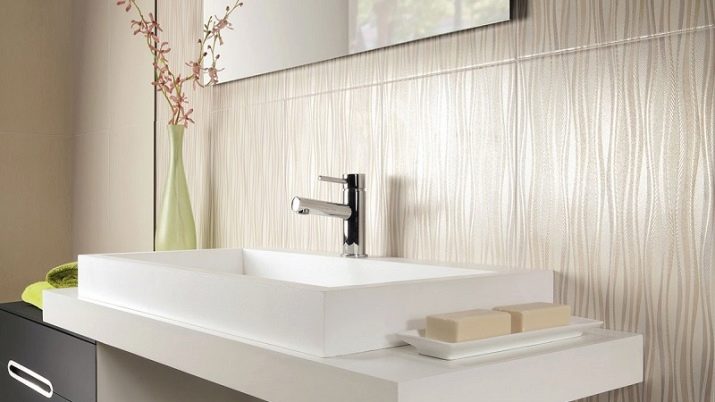
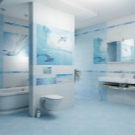
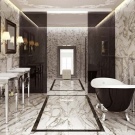
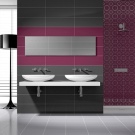
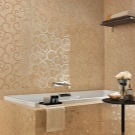
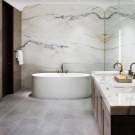
Materials
Tiles for bathrooms are usually made from a special mixture, which includes sand, clay and various additives. In order for the decorative product to be durable, it is fired (once or twice). Tiles made using double firing technology are stronger and can be used not only for wall decoration, but also for other surfaces. Depending on the production technology, tiles are divided into two types.
- Unglazed. The product is characterized by the absence of a decorative coating, has the same appearance and thickness on both sides.
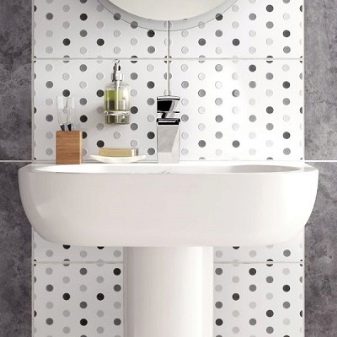
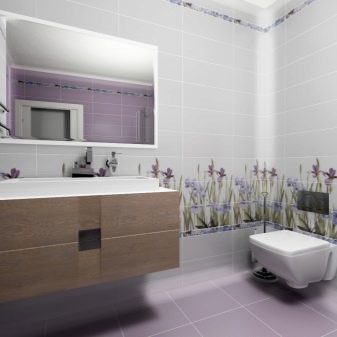
- Glazed. This material provides the walls with water resistance, durability and gives the interior a beautiful look, since a color and textured coating is applied to its front side.

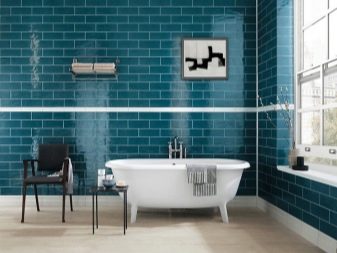
For the manufacture of wall tiles in the bathroom, manufacturers use various materials.
- Porcelain tile. Outwardly, it resembles natural stone. It is made on the basis of high quality clay with the addition of previously ground rocks (quartz, spar). Usually porcelain tile has a granular or granular structure throughout its depth.The material is resistant to temperature extremes and cracking.
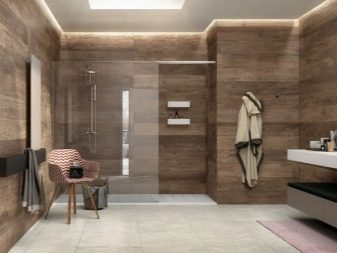
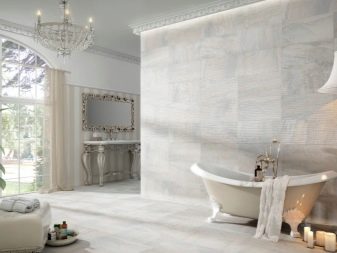
- Quartz vinyl. Products of this type are an excellent alternative to wallpaper. They are produced from the base layer of fiberglass coated PVC. In addition, quartz is added to its composition. Additionally, a decorative layer with an imitation of any texture is applied to the tile. Due to the protective coating of polyurethane, the products also have a high degree of wear resistance. Vinyl tile has the only drawback - it requires careful preparation of the walls before facing, otherwise all the bumps and flaws will appear on its surface.
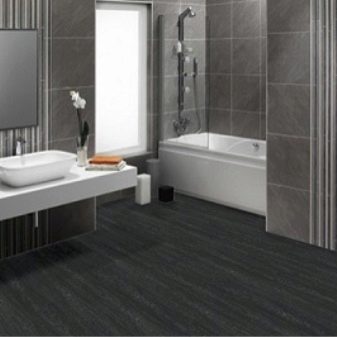
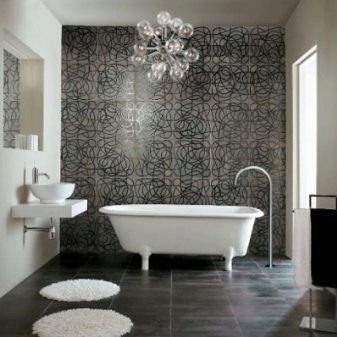
- Ceramic (tiled). It is made from a mixture of clay, feldspar and quartz sand. In its strength, ceramic tile is absolutely no worse than natural granite and has high strength and aesthetic appearance. There are several types of ceramic tiles: faience (glazed product undergoing double firing), clinker (produced from various types of clay, it has a soft structure), cotto (characterized by the presence of natural shades of clay and has a porous structure).
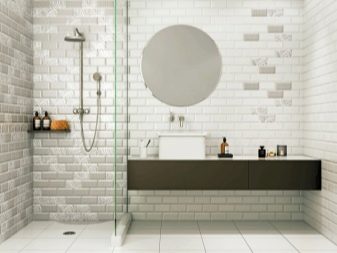

Dimensions
Wall tiles designed to decorate surfaces in the bathroom can be either large or small. Rectangular tiles are available in sizes of 15 * 25, 20 * 25, 33 * 45 and 30 * 60 cm, square ceramic - 2.5 * 2.5, 5 * 5, 10 * 10, 20 * 20, 40 * 40, 60 * 120 and 120 * 120 cm. As a rule, for wall cladding in the bathroom most often choose a tile measuring 50x20 cm, its thickness does not exceed 9 mm. If the room is small, then a wall tile 10 * 10 or 20 * 20 cm in size is chosen for design.
It is ideal for creating mosaic patterns and allows you to visually expand the space of the room, giving it a stylish look.
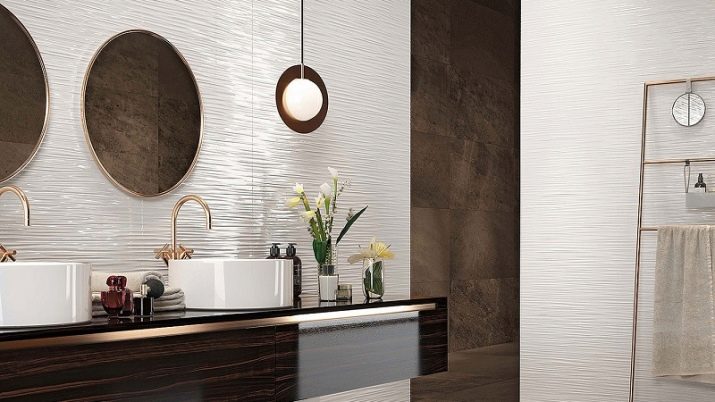

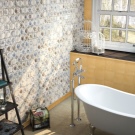
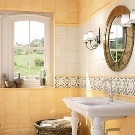

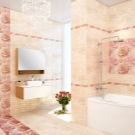
Colors and their combination
Before you start decorating the interior of the bathroom, it is important to think about the layout and choose the right color for the finish. As a rule, for decorating the walls in this room, tiles with a marine theme are chosen and preferring green, blue and white. Creating a design, one should not forget about the rules of combining shades among themselves. Otherwise, the room may turn out to be too dull, monophonic or, conversely, bright. Many designers choose to design bathrooms either cold or warm shades.
The interior in the bathroom can be both colorful and monochrome. In the first case it is necessary to skillfully combine various shades (at least 3 and no more than 6), and in the second - use furniture, accessories and decoration of the same color, but in different colors. The bathroom looks gorgeous in a yellow-green palette, where only two colors are used - lemon-cream or yellow and green.

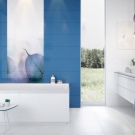
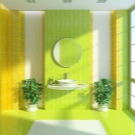
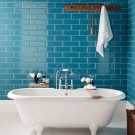
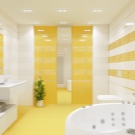
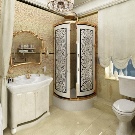
Red color excites and invigorates, so if in the morning you need to be well charged with positive energy, then you should wall the walls with red ceramic in the bathroom. In order not to overdo it with brightness, it is recommended to supplement red with white.
Bathrooms also look good in orange. In this case, orange tiles can be safely combined with other types of finishes. cream, white, gray, blue and green. To get an interior filled with an atmosphere of comfort, you can tiling the walls caramel, cream and light brown. It should be in harmony with furniture and other accessories.
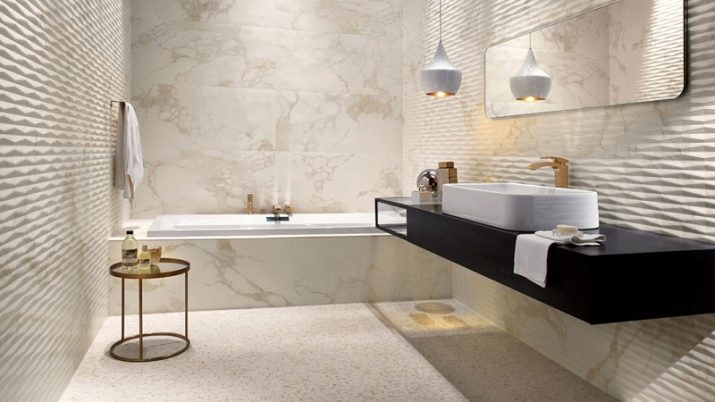
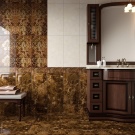
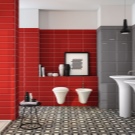
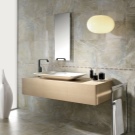
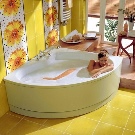
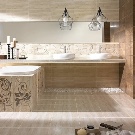
Design
Today, wall tiles in the bathroom are presented in a huge variety, which makes it easy to pick up for any style of room. Designers recommend choosing to design bathrooms material with a nautical theme, decorating one of the walls with 3D effect tiles.
If you plan to create a design in the room in a modern style, then it is best to give preference light or dark tiles with geometric relief and abstract patterns. Tiles with imitation of such natural stone as onyx, travertine and marble also look interesting in the bathroom. They are very popular and products with hand-drawn or mosaic decor.
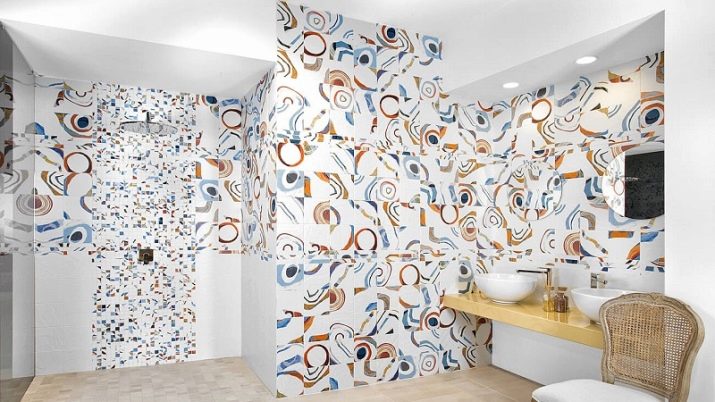
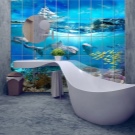
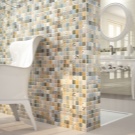
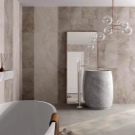
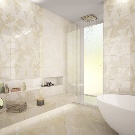
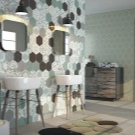
For large bathrooms ceramic tiles with delicate floral motifs work great. In addition, on sale you can find tiles with imitation of concrete, dark wood and brushed metal (brass, cast iron and copper). Ceramics in silver or gilding will also help to give chic to the interior.
To make spending time in the bathroom fun and enjoyable, It is recommended to purchase wall tiles with images of fairy-tale characters or with drawings of pirates, ships and fish. As a rule, this type of tile is sold in a kit, from which it is easy to lay out the original panel.
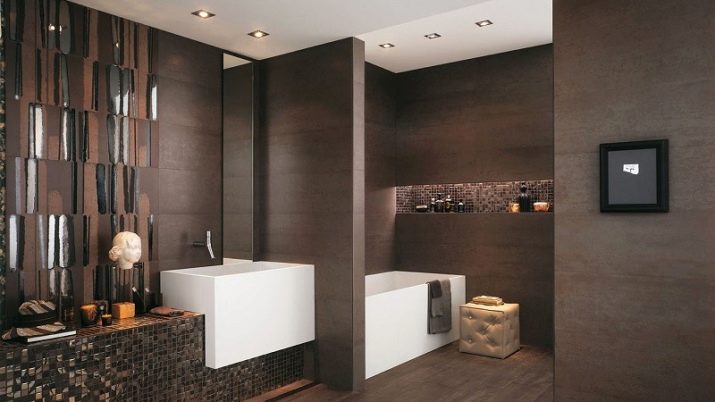
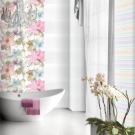
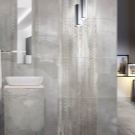

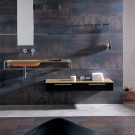
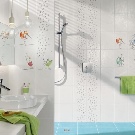
How to choose?
A classic type of bathroom decoration is tile. It is characterized by high strength, moisture resistance and is presented on the market in a huge assortment. So that the decorative finish lasts a long time and delights with its attractive appearance, When buying tiles, it is important to pay attention to the following indicators.
- Absorbency. Since this room is characterized by high humidity, its walls need to be faced only with material that is resistant to water. Otherwise, its life will be short. The tile, absorbing moisture, becomes heavy and quickly peels off the surface. In addition, under the influence of water and steam, its external surface may lose aesthetic qualities. At the time of purchase, it is best to give preference to a product with a minimum number of pores.
- Resistance to aggressive detergents. The bathroom requires frequent cleaning, because it should constantly maintain a high level of hygiene. In order for the decorative finish to “withstand” frequent surface cleaning, it is necessary to purchase a facing material, on which a protective layer is applied to the front surface.
- Appearance. The reverse side of the tile should be flat. If there is a presence of bulges, depressions and irregularities, then it is better to refuse the purchase. In addition, it is important to pay attention to the quality of drawing. In a quality product, the surface does not have a raster, and the image is characterized by a uniform color.
- Combination with furnishings. For small rooms, it is impossible to purchase material in dark tones, since it will visually narrow the space. In this case, facing the top with a light tile and the bottom with a dark one will be the right solution.
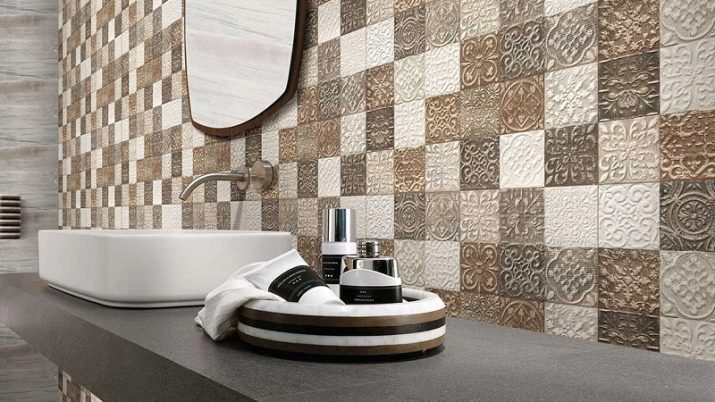
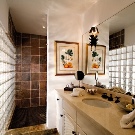
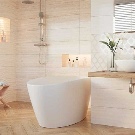
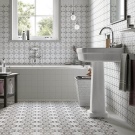
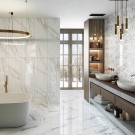
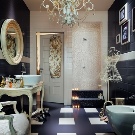
Before you buy a tile in the bathroom, you should also decide on its size. To do this, pre-measure the room.
Oversized tiles are suitable for lining the walls of large rooms, and for small ones in the form of small fragments (mosaics).
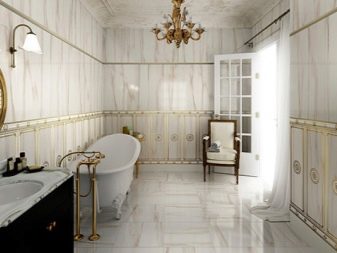
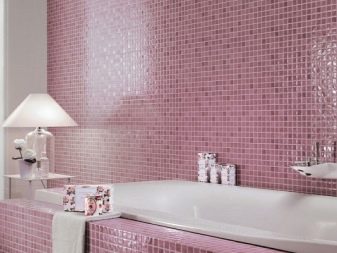
Styling methods
After the issue with the choice of design and material is resolved, it remains only to complete the installation of tiles. Since it is necessary to put it only on previously prepared walls, first they dismantle the old coating, then put the plaster and carry out its priming. On a well-prepared base, wall tiles can be laid in several ways.
- Horizontal row. Finishing begins from the bottom of the wall or from the sides of the bath. It all depends on which section of the wall you plan to decorate. Often they tiled the entire room with tiles, or only a washbasin, the location of the washing machine and bathtub.
- Vertical row. Masonry begins to perform from the central part of the wall. Thanks to this technique, the corners are closed with tiles of equal size.
- Seam to seam. Tiles are laid one after another, both in a row and horizontally. This cladding technique is often also called a “chessboard”.
- Dressing up. Externally, this finish is similar to brickwork.Each lower row of tiles must be laid with a slight shift by half a tile.
- Diagonal. Wall tiles must be laid at an angle to the seam in the seam with respect to each other so that a rhombus forms.
- Patchwork. Such decoration requires the presence of a multi-colored tile, which does not have a common theme and pattern.
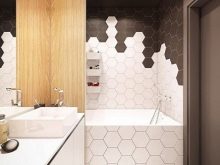
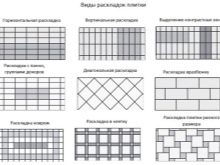
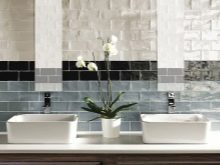
What can be replaced?
In many bathrooms you can find old tiles, which have been lined with walls since Soviet times. Despite the fact that such a decoration has been successfully preserved to our time, its decorative appearance does not fit into modern design. The rooms in this design resemble operating rooms in hospitals. To update the interior of the room and give it a stylish look, you should dismantle the old tile and install a new one.
Since quality tiles are expensive, there is an alternative to replacing them with plastic panels or siding. Before this finish there is no need to level the surface and even beginners can quickly cope with the installation. But when buying material you need to pay attention to the level of its moisture resistance.


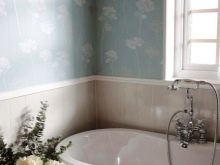
A good idea is pasting the walls with waterproof wallpaper, but before its implementation it is necessary to carefully prepare the walls: remove the old tile, level the base and treat it with an antifungal agent.
They look especially beautiful in bathrooms fiberglass wallpaper, which, if desired, can be painted latex paint. Liquid wallpaper, which has high water resistance, is also very popular. They come in a wide variety of colors.
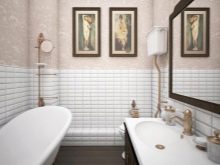
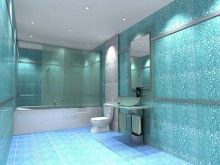
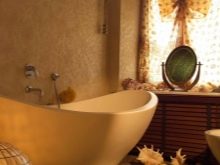
How to care?
Wall tiles, just like other decorative coatings in the bathroom, need careful maintenance, due to this, their life will be prolonged and their aesthetic appearance will be preserved. After each shower and any other water treatment, the tiles must be wiped dry with a soft cloth. If this is not done, then moisture, condensation and vapor will provoke the appearance of not only dark spots, but also the fungus. Tiles must be cleaned with a sponge and an abrasive-free detergent. Cleaning agent should besparing not only in relation to the tile, but also to the inter-tile grout.
Before applying any detergent to the surface of the tile, you need to familiarize yourself with the instructions for caring for it, which is indicated to the manufacturers, and follow all its points. To extend the life of ceramic tiles (especially for products with frosted glaze), it is recommended to additionally wipe the surface with a special emulsion. It allows unglazed surfaces to acquire a beautiful shine, and matte - a fresh look. In addition, the emulsion on the surface of the walls creates excellent protection against mechanical damage and rapid contamination.
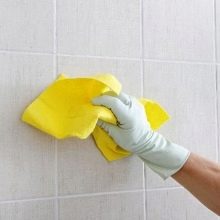
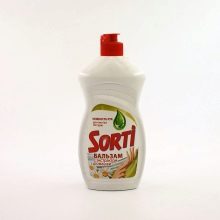
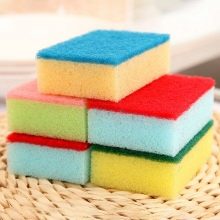
Beautiful examples in the interior
Thanks to a huge selection of finishing materials, among which wall tiles are in great demand, it became simple to design a bathroom. Today, there are many interesting ideas on how to turn a simple bathroom into a stylish and practical place in the house.
- Loft style. To implement this design project, you will need to perform a wall decor with a rough coating, and fill the room itself with non-standard accessories. From the tile it is necessary to lay out a semblance of a brick wall, observing the dressing scheme with a slight shift of the rows. It is best to imitate brickwork with a rectangular tile. As for the color scheme, gray is a good choice.
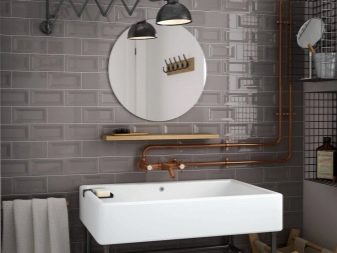
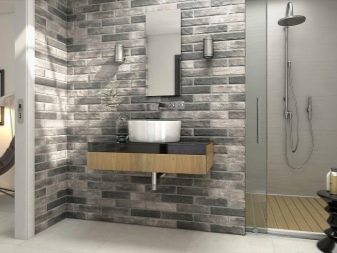
- With oriental motifs. For lovers of a bright color palette, the bathroom design, decorated with wall tiles with thematic ornaments, is suitable. If the room is small, then the wall cladding can be done with a tile of triangular or hexagonal shape. To visually expand the space, you need to use two colors in the interior.Lay out a light tile on top, a dark one on the bottom, and a tile with a photo print or geometric pattern in the center.
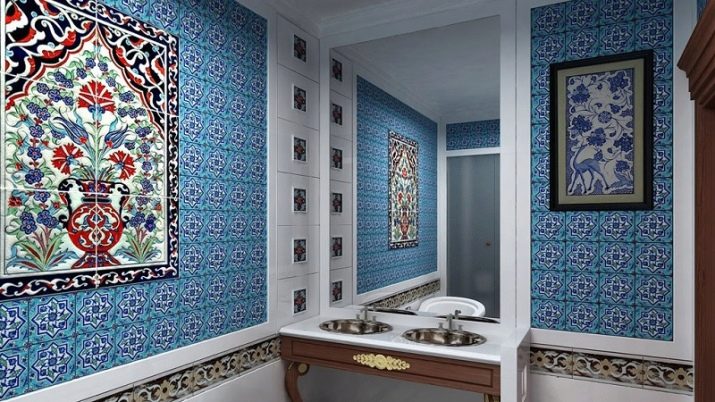
- Design with wooden motifs. In this version, the bathroom will always look cozy and beautiful. The tile with imitation of a natural tree will allow to create the atmosphere of a country bath in the room. For the best effect, all walls should be tiled and the interior should be complemented with porcelain stoneware. It will be interesting to look in the bathroom tile with imitation of walnut, pine, cherry and alder wood, which is difficult to distinguish from natural material.
If the room is small, then it is best to finish it with a light coating.
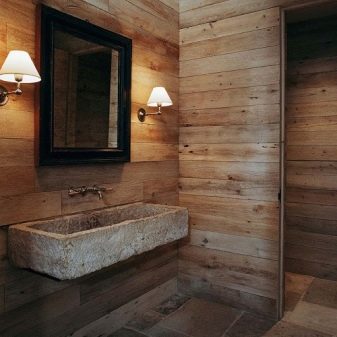
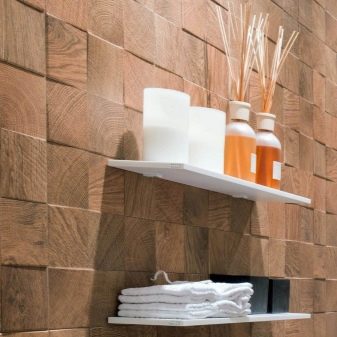
- Snow-white interior. White color is a symbol of purity and harmony, but to design the design of bathrooms it should be diluted with dark shades. For example, wall decoration with white ceramics decorated with small decorative elements will become an original idea. You can veneer white tiles on the sides of the wall, and mosaic lavender-colored elements inside.
Shades can be emphasized with glass and metal.
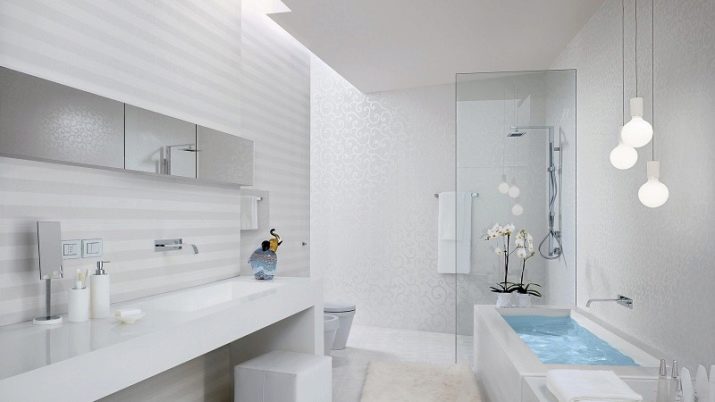
In the next video, you will find laying the wall tiles in the bathroom with your own hands.
